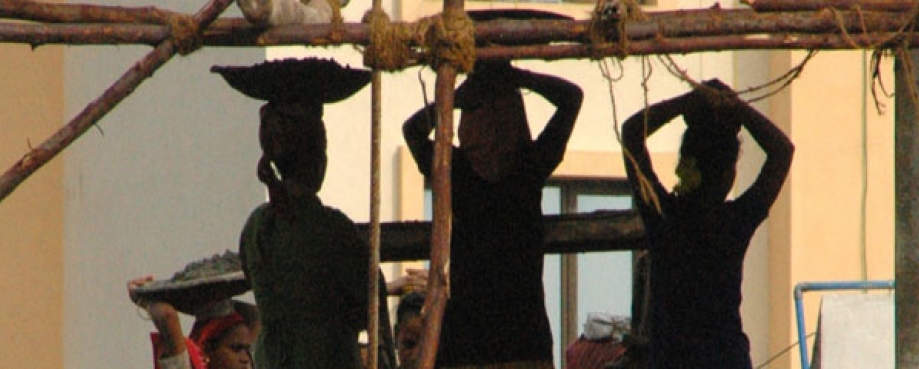
A year ago, I posted a blog on the six month anniversary of the Rana Plaza disaster, and asked the question: where will the next one be? And I suggested that India would be a good place to look.
Well, I told you so. What is happening is a Rana Plaza in slow motion. Not the spectacular, headline grabbing numbers of a single catastrophe, but overall, the body count is the same. Buildings are not collapsing around garment workers producing for western brands. These buildings are falling down before construction is even finished.
How do I know? This summer while you, gentle reader, were lying on a beach somewhere, I was reading through an entire year’s worth of Trade Union Record, a journal produced by the All India Trade Union Congress, the oldest workers’ organisation in India. It was tough going. I was a postgraduate student for three years, and the subject of my thesis was trade unionism in Hull, 1910 - 1940 (don’t laugh). So I have a very high tolerance level of dull union journals but believe me, the Record is great for insomnia. But Record by name, record by nature. A lot of articles are just straight reprints from the local Indian press. And here we find the small or not so small catastrophes that are routine for workers in India.
In January, 31 construction workers were killed when a building collapsed around them in Goa. 16 more were injured. The building permit had been issued contrary to law and a TV investigation found that permits were still being issued weeks after the disaster.
In Chennai, (formerly Madras), at the end of June, an 11-storey building under construction collapsed with around 70 workers inside and 47 of them were killed - that is the official figure, although some estimates of the death toll are higher.
Less than a week later, still in Chennai, a wall collapsed, killing 11 building workers while they were sleeping - the collapse happened at night. A high percentage of India’s 20 million construction workers are interstate migrant workers, and such workers always live on site, with no facilities at all. There's no accommodation, no toilets - they just make their own arrangements, and often have their families with them. Round about 6000 construction workers are killed every year in India; these aren't official figures, I've estimated this from the little data that we have.
There is a special law to protect them: the Inter State Migrant Workers Act. The excellent standing committee on labour of the Lok Sabha (the lower house of Parliament) examined the Act in its 2010-2011 session and it asked the Ministry of Labour how many prosecutions there had been.
Go on, have a guess.
Zero. Zilch. Nada. Nowt.
Another good one is the Building and Other Construction Workers (Regulation of Employment & Conditions of Service) Act, 1996.
This is a really tough piece of legislation. Employers who break the law can be fined 2000 rupees and an extra 100 rupees a day as long as the violation of the law continues. That is a £20 fine for breaking the law and £1 a day thereafter.
The law also mandates that every state must set up a construction workers welfare board. Nearly one decade after the law was passed, some states still haven't set up the boards. And those states that have, well, the boards just don't meet.
You can guess how many prosecutions there have been.
The problem in India is not the lack of laws to protect workers; there are 44 separate national labour laws, plus the ones at state level. As the Roman writer Terence put it corruptissima re publica plurimae leges (loosely translated: the more laws, the more corrupt the state).
All these different laws have different definitions of worker, different trigger points for when they come into effect and this provides a field day for lawyers and corrupt officials.
There is an urgent need for consolidation and simplification of labour law in India. However that by itself is not sufficient. In Bangladesh, all the labour laws were tidied up and consolidated into one single act in 2006. You couldn't claim that tidying up the law there improved safety standards, or any area of workers’ rights.
It’s not just labour law. Only 6.7% of chartered accountants and 1.8% of lawyers in India file tax returns.
Back in the days of the Mogul empire (roughly the period of the Tudors and Stuarts in British history) there was a saying, “Dilli dur hey” - Delhi is far away. It expressed the idea that the government may pass a law, but it does not count for much. Obeying the law is optional.
There needs to be a change in the culture of compliance at all levels.
These building collapses are the canary in the coal mine. As the mining industry is now extinct in the UK, that may need an explanation. In the late 19th century, John Scott Haldane (who invented the gas mask during the Great War) worked out that if miners took canaries down the mine they were an early warning of dangerous levels of carbon monoxide underground. With a faster metabolism, the canaries just fell over if gas levels became critical for the miners, and so they could get out. Astonishingly, canaries were still being used in British mines well into the 20th century.
History lesson over.
So, this is the big question: if buildings in India are falling down on this scale even BEFORE they are completed, what is the state of factories that are operating?
We do not want to see a Rana Plaza in India.
